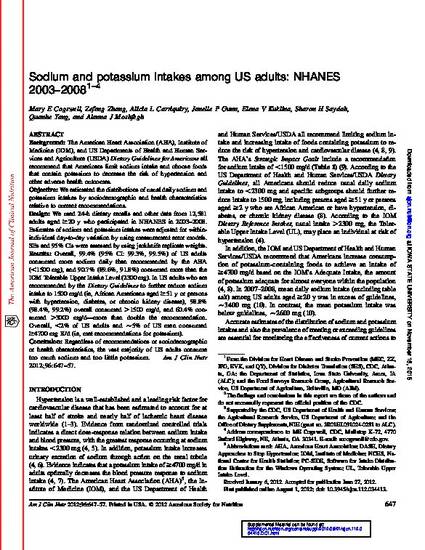
Article
Sodium and potassium intakes among US adults: NHANES 2003–2008
American Journal of Clinical Nutrition
Document Type
Article
Disciplines
Publication Version
Published Version
Publication Date
1-1-2012
DOI
10.3945/ajcn.112.034413
Abstract
Background: The American Heart Association (AHA), Institute of Medicine (IOM), and US Departments of Health and Human Services and Agriculture (USDA) Dietary Guidelines for Americans all recommend that Americans limit sodium intake and choose foods that contain potassium to decrease the risk of hypertension and other adverse health outcomes. Objective: We estimated the distributions of usual daily sodium and potassium intakes by sociodemographic and health characteristics relative to current recommendations. Design: We used 24-h dietary recalls and other data from 12,581 adults aged $20 y who participated in NHANES in 2003–2008. Estimates of sodium and potassium intakes were adjusted for withinindividual day-to-day variation by using measurement error models. SEs and 95% CIs were assessed by using jackknife replicate weights. Results: Overall, 99.4% (95% CI: 99.3%, 99.5%) of US adults consumed more sodium daily than recommended by the AHA (,1500 mg), and 90.7% (89.6%, 91.8%) consumed more than the IOM Tolerable Upper Intake Level (2300 mg). In US adults who are recommended by the Dietary Guidelines to further reduce sodium intake to 1500 mg/d (ie, African Americans aged $51 y or persons with hypertension, diabetes, or chronic kidney disease), 98.8% (98.4%, 99.2%) overall consumed .1500 mg/d, and 60.4% consumed .3000 mg/d—more than double the recommendation. Overall, ,2% of US adults and w5% of US men consumed $4700 mg K/d (ie, met recommendations for potassium). Conclusion: Regardless of recommendations or sociodemographic or health characteristics, the vast majority of US adults consume too much sodium and too little potassium.
Rights
Works produced by employees of the U.S. Government as part of their official duties are not copyrighted within the U.S. The content of this document is not copyrighted.
Language
en
File Format
application/pdf
Citation Information
Mary E. Cogswell, Zefeng Zhang, Alicia L. Carriquiry, Janelle P. Gunn, et al.. "Sodium and potassium intakes among US adults: NHANES 2003–2008" American Journal of Clinical Nutrition Vol. 96 Iss. 3 (2012) p. 647 - 657 Available at: http://works.bepress.com/alicia_carriquiry/45/

This article is from American Journal of Clinical Nutrition 96 (2012): 647, doi: 10.3945/ajcn.112.034413.